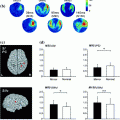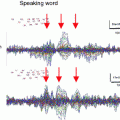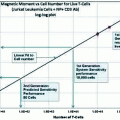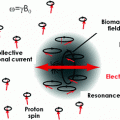Fig. 1
Left panel Mixed sensor schematic; a superconducting loop (yellow) containing a constriction reacts to the applied field Bext by generating a supercurrent (white arrows) which, passing through a constriction, exhibits an amplified local field B’. This field can be detected by the GMR element (light blue) placed on top or below the constriction. The GMR element is designed in a yoke shape which allows reducing the magnetic domain noise. Right panel: Photograph of a YBCO-mixed sensor. The YBCO appears in dark brown; the GMR contact pads can be seen at the bottom of the figure (light grey squares)
3 Detectivity
The detectivity, also called field equivalent noise, is the voltage noise of the sensor given in  divided by the sensitivity given in V/T. It represents the field for which a Signal-to-Noise Ratio (SNR) is one. This allows for an easy comparison between the performance of various sensors that are at strengths similar to biomagnetic sources.
divided by the sensitivity given in V/T. It represents the field for which a Signal-to-Noise Ratio (SNR) is one. This allows for an easy comparison between the performance of various sensors that are at strengths similar to biomagnetic sources.
 divided by the sensitivity given in V/T. It represents the field for which a Signal-to-Noise Ratio (SNR) is one. This allows for an easy comparison between the performance of various sensors that are at strengths similar to biomagnetic sources.
divided by the sensitivity given in V/T. It represents the field for which a Signal-to-Noise Ratio (SNR) is one. This allows for an easy comparison between the performance of various sensors that are at strengths similar to biomagnetic sources.The detectivity of SQUIDs used in MEG is in the range of  down to several Hz. High-Tc SQUIDs made with YBCO have a detectivity of the order of 30 fT/sqrt(Hz).
down to several Hz. High-Tc SQUIDs made with YBCO have a detectivity of the order of 30 fT/sqrt(Hz).
 down to several Hz. High-Tc SQUIDs made with YBCO have a detectivity of the order of 30 fT/sqrt(Hz).
down to several Hz. High-Tc SQUIDs made with YBCO have a detectivity of the order of 30 fT/sqrt(Hz).For mixed sensors, the noise is given by the GMR element; the superconducting loop does not contribute to the noise since it operates in the purely non-resistive state. The noise is comprised of two contributions; the thermal noise which is flat in frequency and the low frequency noise (1/f noise) with a power spectral density decreasing as 1/f. For that reason, mixed sensors are more sensitive at high frequencies than at low frequencies. Figure 2 gives the detectivity of a small-size YBCO sensor as function of frequency.
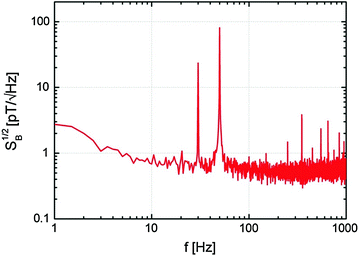

Fig. 2
Equivalent field sensitivity of the Nb-mixed sensor coupled with a flux-transformer obtained from the power spectrum density, calibrated using a test signal of 25 pT at 30 Hz, generated by an external coil. The main power supply (50 Hz) signal is of the order of 80 pT in the MSR. At 10 Hz, the detectivity is around 700 fT

4 MCG and MEG Applications
Stay updated, free articles. Join our Telegram channel

Full access? Get Clinical Tree



